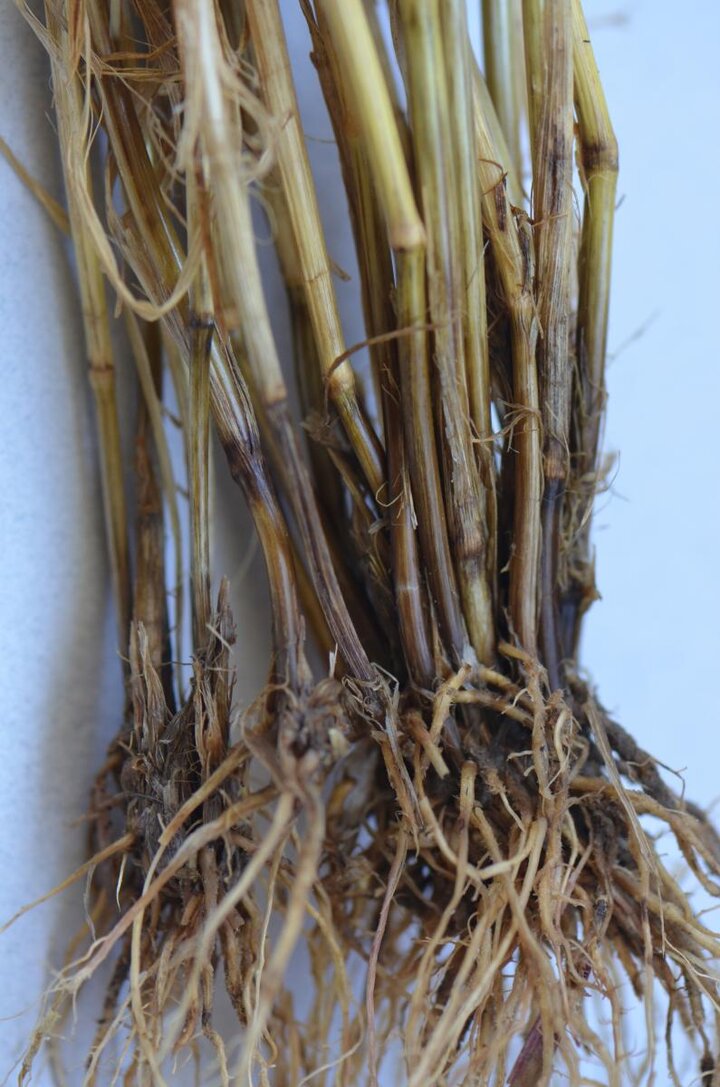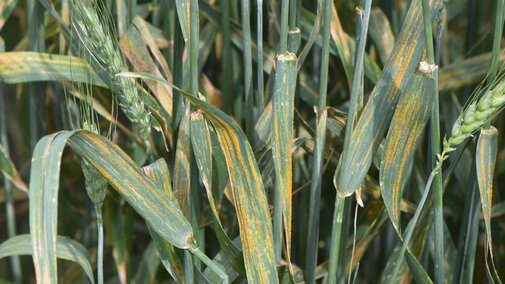In 2019, wet weather during the growing season favored the development of wheat diseases including Fusarium head blight, leaf rust, stripe rust, bacterial streak, and take-all. This update highlights these diseases, the environmental factors that favor their development, and their management.
Fusarium head blight:
Fusarium head blight (FHB, scab) is caused mainly by the fungus Fusarium graminearum, but other Fusarium species including F. boothii which was recently found in Nebraska wheat fields, are causal agents. In Nebraska, FHB occurs sporadically, but it can be devastating when it does. The most FHB-prone regions in Nebraska are the southeast, south central, and southwest. Major, widespread epidemics during the last 15 years occurred in 2007, 2008, 2015, and 2019. The most important predisposing factor is excessive and frequent rainfall before and during flowering. The disease is characterized by premature bleaching of wheat heads (Figure 1). Yield loss results mainly from sterility of infected spikelets on the head and reduction in kernel size. In addition, grain quality is reduced due to presence in the grain of the mycotoxin deoxynivalenol (DON, vomitoxin) and the presence of shriveled, discolored kernels known as Fusarium-damaged kernels (FDK) or “tombstones” that are unsuitable for milling, baking, and malting. In years with severe epidemics, yield loss in individual fields typically ranges from 20% to 50%, but can be 100% in seed production fields or if the vomitoxin level is so high that elevators cannot accept the grain. Management strategies for FHB include the use of moderately resistant varieties, application of a triazole or an SDHI fungicide at flowering, and rotation with a non-host crop such as soybean.
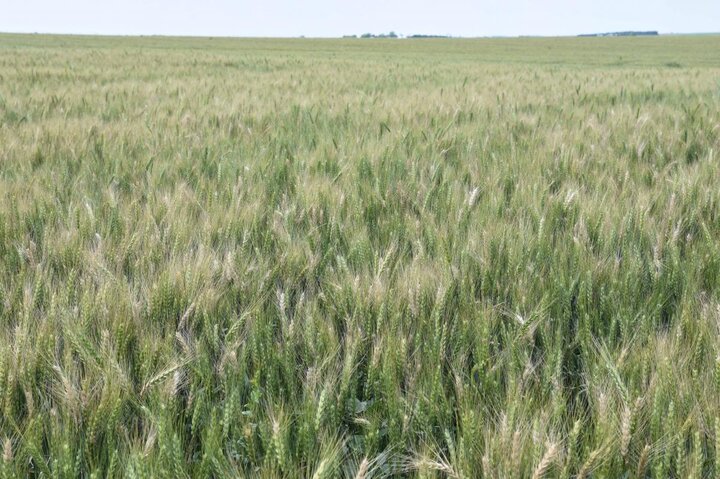
Leaf rust:
Leaf rust, also known as brown rust, is caused by the fungus Puccinia triticina. It is generally distributed throughout eastern and central Nebraska and occurs sporadically in western Nebraska. It usually does not overwinter in Nebraska due to subfreezing winter temperatures. During each growing season, spores are blown into our region from southern states where it overwinters. In Nebraska wheat fields, the disease starts developing in late May to early June and is most damaging when the upper leaves of infected plants become severely rusted before flowering. Heavy rusting causes early loss of these leaves, which reduces the grain filling period and results in smaller kernel size. Leaf rust produces orange-brown uredinia (fruiting bodies) in pustules primarily on the upper surface of leaves (Figure 2). The uredinia are round or slightly elongated, erumpent (breaking through the leaf surface), and do not cause conspicuous tears in the epidermal tissues as do those of the stem rust fungus. Under favorable conditions for disease development (wet weather and moderate to warm temperatures), uredinia can cover nearly the entire upper leaf surface. Numerous spores known as urediniospores are formed in the uredinia. The spores are disseminated within and between fields by wind or blowing rain and cause new infections every 7 to 10 days. Leaf rust is managed by planting resistant varieties and application of a fungicide timed to protect the flag leaf.
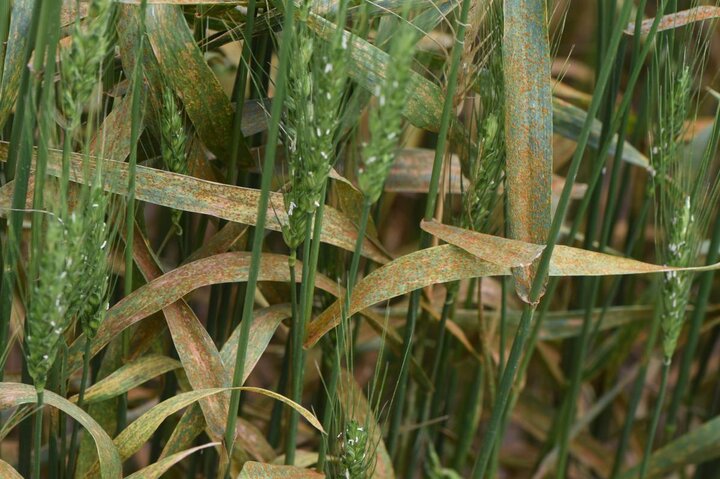
Stripe rust:
Stripe rust, also known as yellow rust, is caused by the fungus Puccinia striiformis f. sp. tritici. Before 2000, stripe rust in the U.S. occurred mainly in the Pacific Northwest and California. Since 2000, it has become increasingly common in the south central and central Great Plains. The most recent major epidemics of stripe rust in Nebraska occurred in 2010, 2012, and 2015. Initial symptoms are chlorotic patches on leaves. Yellow to orange uredinia develop in these patches and form distinct stripes on mature, upper leaves (Figure 3). Under favorable environmental conditions (wet weather and cool temperatures), entire leaf surfaces can be covered with stripes. Distinct stripes do not form on seedling leaves. Stripes or necrotic spots vary in size depending variety resistance and environmental conditions. Uredinia can form on glumes on the wheat head, and occasionally immature grain can be infected. Uredinia contain urediniospores which are spread within and between fields by wind or blowing rain and cause new infections every 7 to 10 days. Rapid desiccation of the entire plant can occur due to utilization of water and nutrients by the stripe rust pathogen. Like leaf rust, during each growing season stripe rust spores are blown into our region from southern states where it overwinters. Because it is favored by cool temperatures, it starts developing in Nebraska wheat fields in April. Stripe rust is managed by planting resistant varieties and application of a fungicide timed to protect the flag leaf.

Bacterial streak and black chaff:
Bacterial streak and black chaff is a disease of wheat common in irrigated fields or in areas with abundant rainfall during the growing season. It occurs on both leaves (bacterial streak, Figure 4) and heads (black chaff, Figure 5). The disease also occurs on barley, oats, rye, triticale, and many grasses. It is the most important and most widely distributed bacterial disease of small grains and can cause yield losses of up to 40%. The disease occurs sporadically in Nebraska wheat fields, but has become more frequent during the last 10 years. It is caused by the bacterium Xanthomonas campestris pathovar (pv.) translucens. The disease derives its “black chaff” name from the darkened glumes on infected heads (Figure 5). This symptom is similar to that caused by genetic melanism (darkening of tissue) and glume blotch incited by Stagonospora nodorum. Bacterial streak and black chaff can be distinguished from other diseases by the appearance of cream to yellow bacterial ooze in the form of slime or viscous droplets produced on infected plant parts during wet or humid weather. This ooze appears light colored and scale-like when dry. Bands of necrotic and healthy tissue on awns (‘barber’s pole’) are indicative of black chaff. A dark brown to purple discoloration may appear on the stem below the head and above the flag leaf. The most effective management strategy for black chaff is the use of certified, pathogen-free seed. Controlling volunteer cereals and grassy weeds can help to reduce primary inoculum. Irrigation management helps to create an environment that is less favorable to disease development.
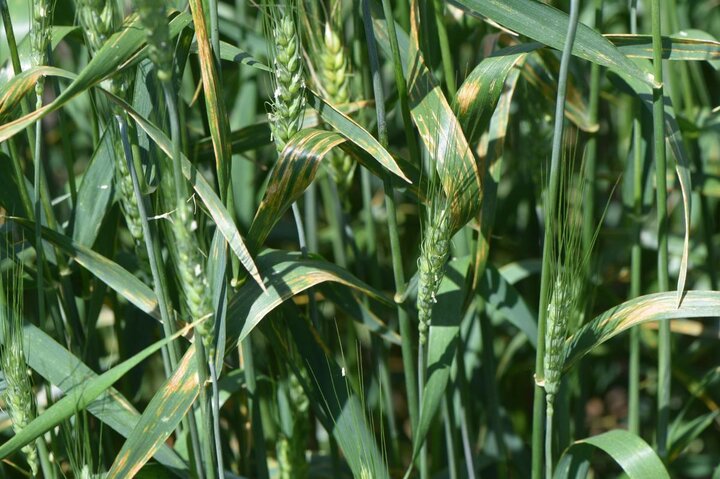
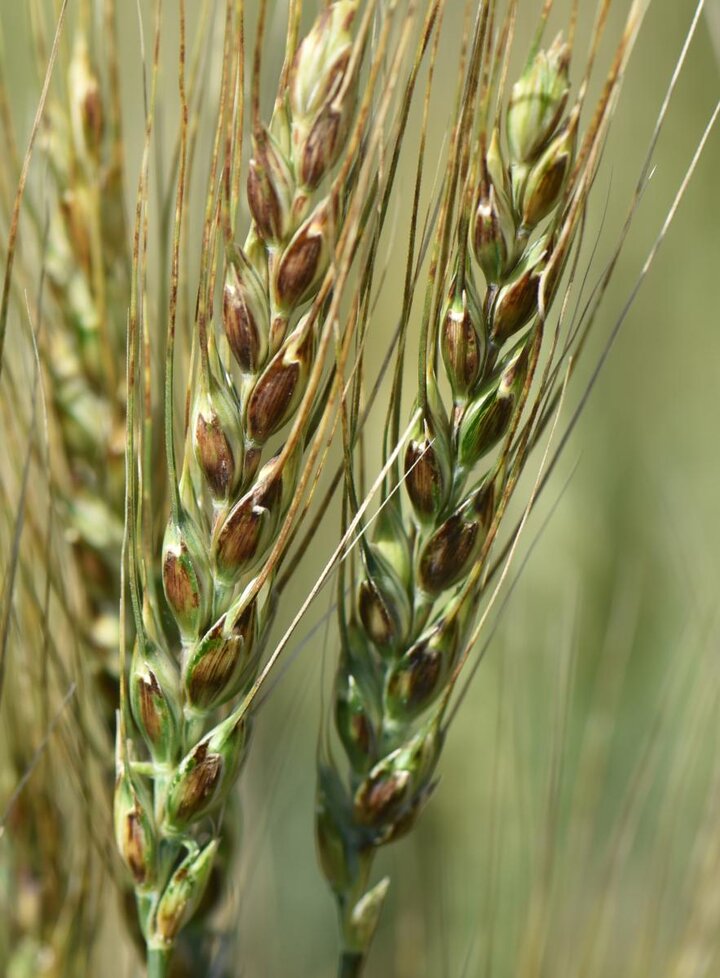
Take-all:
Take-all of wheat is caused by the fungus Gaeumannomyces graminis var. tritici (Ggt). Ggt survives as mycelium in wheat residue. Roots are infected by mycelium growing from the residue. A brown to black rot is initiated and develops upward into the crown and up to the stem base (Figure 6). Infected plants are stunted and mildly chlorotic with fewer tillers. Some tillers die prematurely resulting in distinctively bleached and sterile heads with shriveled kernels. Infected plants pull up easily or break near the soil line due to brittle stem bases. Take-all can cause up to 20% yield loss. Strategies for management of take-all include crop rotation, avoiding early planting in the fall, and fungicide seed treatments.
